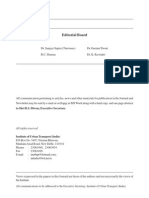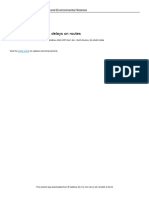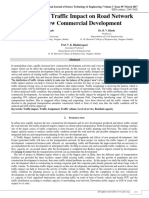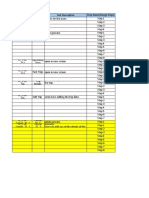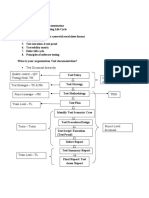Professional Documents
Culture Documents
254 Study
254 Study
Uploaded by
akshayOriginal Title
Copyright
Available Formats
Share this document
Did you find this document useful?
Is this content inappropriate?
Report this DocumentCopyright:
Available Formats
254 Study
254 Study
Uploaded by
akshayCopyright:
Available Formats
ISSN(Online): 2319-8753
ISSN (Print): 2347-6710
International Journal of Innovative Research in Science,
Engineering and Technology
(An ISO 3297: 2007 Certified Organization)
Website: www.ijirset.com
Vol. 6, Issue 5, May 2017
Study of Road Traffic & Management: A Case
Study at Katraj and Nalstop Intersections In
Pune City
Gayatri S Choudekar 1, Rohit R Salgude 2
P.G. Student, Department of Civil Engineering, Maharashtra Institute of Technology, Pune, Maharashtra, India1
Assistant Professor, Department of Civil Engineering, Maharashtra Institute of Technology, Pune, Maharashtra, India2
ABSTRACT: The increasing number of vehicles in the city, leading to traffic congestions is the major hurdle in the
development of the city. Thus there is a need for proper road traffic demand management for the city. The objectives of
the paper are tostudy the various problems faced by the city for two locations(viz. Katraj Intersection and Nalstop
Intersection), and also presents solution for the traffic demand management at the intersections. The study is based on
the road resources and characteristic of the urban traffic found from the video recordings done at the junction for 8 days
during the peak and non-peak hours. Based on the Vehicular Volume Dataand Turning Movement Survey observed at
these intersections, the paper discusses the solution to the increasing congestion and its effect on the traffic.
KEYWORDS: Non-Peak Hours,Peak Hours,Road Traffic Demand Management, Traffic Congestion, Turning
Movement Survey, Vehicular Volume Data
I. INTRODUCTION
The city of Pune is the second largest district in the state of Maharashtra and covers 5.10% of the total geographical
area of the state. The roads and rail networks connect the district with the state capital and surrounding district
headquarters. The road network of the city comprises of Express Highways, National Highways, State Highways,
Major District Roads and village roads.The total length of roads in the district is 13,642 km of roads(2001) of which
39.54% roads have Bituminous surface, 26.05% roads are of water bound macadam surface and 34.41% roads are other
surface roads i.e. unmetalled road.Of the total road length in the district, National Highways covers 331km road length;
State Highways cover 1368 km road length. Almost all the villages are well connected by water boundmacadam road.
Transport policies such as road widening, construction of flyovers, etc. have already beenimplemented in the city. But
the traffic congestions still exist as the policies do not meet the increasing traffic demand. The traditional solution of
“building more roads and constructing more road infrastructure to accommodate the increasing number of vehicles”
will not be able to meet the traffic demand management of the city. In order to improve the traffic demand management
and traffic planning of the city, it is necessary to guide the increasing traffic demand along with the road widening and
road infrastructure development. This can lead to a better, comfortable, reliable, economic as well as environment-
friendly solution to the existing problem.
The research work studies two intersections in the city (i.e. Katraj intersection and Nalstop intersection), the former
situated in the outskirts of the city and the later in the heart of the city. The two intersections are one of the busiest
intersections in the city. There are a number of factories and small scale furniture industries located in a radius of 10 to
15 km near Katraj intersection. Also the continuous development of the areas in the outskirts necessitates the import
and export of materials and other items from the bypass, thus increasing the number of multi axle vehicles at the Katraj
intersection. The intersection also has a main PMPML bus depot, thus making the intersection more congested. The
Nalstop intersection has a major district road going from Deccan to Kothrud and vice versa. In addition to it, is a road
Copyright to IJIRSET DOI:10.15680/IJIRSET.2017.0605254 8801
ISSN(Online): 2319-8753
ISSN (Print): 2347-6710
International Journal of Innovative Research in Science,
Engineering and Technology
(An ISO 3297: 2007 Certified Organization)
Website: www.ijirset.com
Vol. 6, Issue 5, May 2017
coming from Mhatre Bridge at the Nalstop intersection. The traffic flows at the two intersections is as shown in the Fig.
1 (a) & (b).
Fig. 1 (a) Katraj Intersection Fig. 1 (b) Nalstop Intersection
II. RELATED WORK
The literature survey brought many technologies to the notice for implementing efficient traffic planning and
management. Increasing traffic at a higher pace is proving to be a big problem in the city of Pune. The developing
infrastructure for tackling the traffic problem has not eased the problem. Thus, there is a need for effective traffic
planning and management system for Pune city [6,9,10].There are various methods to tackle traffic such as Traffic
management by work flow technique, Intelligent Transport System (ITS) for Indian Cities, Intelligent BRT, ecoMove
Approach, Road traffic congestion in Developing World, BRT, Multi-agent system, and Quantitative problem approach
[12]. Linear regression analysis can be used to find the passenger car equivalent values for the intersection. Video
recording can be used to determine the exact number of vehicles passing at an intersection manually [2].
III. METHODOLOGY
To understand the flow of traffic and traffic characteristics at the two intersections, various surveys were carried out
manually as well as by conducting video recordings for 6 hours (peak hours during morning and evening; and non peak
hour during afternoon) over a period of 8 days. The vehicle volume survey and the turning movement survey were then
carried out at the two intersections. The data was then analysed manually using computer and video viewing
application. The survey was conducted for peak times during the morning and evening. The non peak hour during the
afternoon was also surveyed and the recordings of the same were also obtained.
A speed and delay survey at the intersection was also done by moving car observer method. The average delay time
required by vehicle at the junction is noted and the average speed of travel was also noted in the required formats.
From the data obtained, the PCU (Passenger Car Unit/ Passenger Car Equivalent) values are found according to Indian
standards. The graphs of hourly variation of traffic, traffic composition at the intersection were also plotted.
Copyright to IJIRSET DOI:10.15680/IJIRSET.2017.0605254 8802
ISSN(Online): 2319-8753
ISSN (Print): 2347-6710
International Journal of Innovative Research in Science,
Engineering and Technology
(An ISO 3297: 2007 Certified Organization)
Website: www.ijirset.com
Vol. 6, Issue 5, May 2017
IV. ANALYSIS AND OBSERVATIONS
Following values for Passenger Car Equivalent1 were adopted for the analysis according to IRC 106-1990:
Table1: Passenger Car Equivalent
Type of Vehicle PCE
Two wheelers 0.5
Auto rickshaws 1.2
LCV and Cars 1.4
Buses & Trucks 2.2
Agricultural Tractor 4
and Trailers
From the survey done at Katraj intersection, following observations were noted about vehicle flow characteristics:
(a) For the traffic coming from Mumbai Bangalore Expressway Bypass, 75.9% traffic moves toward Kondhwa
Budruk and 24.1% traffic moves towards Katraj.
(b) For the traffic coming from Katraj, 19.3% traffic moves towards Mumbai Bangalore Expressway Bypass;
75.5% traffic moves towards Pune and remaining 5.2% traffic moves towards Kondhwa Budruk.
(c) For the traffic coming from Pune, 23.7% traffic moves towards Kondhwa Budruk; 45.6% traffic moves
towards Katraj; and remaining 30.7% traffic moves toward Mumbai Bangalore Expressway Bypass.
From the survey done at Nalstop intersection, following observations were noted about the vehicle flow characteristics:
(a) For the traffic coming from Kothrud, 58.5% traffic moves towards Deccan; and 41.5% traffic moves towards
Mhatre Bridge.
(b) For the traffic coming from Mhatre Bridge, 81.1% traffic moves towards Deccan; and 18.9% traffic moves
towards Kothrud.
(c) For the traffic coming from Deccan, 84.5% traffic moves towards Kothrud; and 15.5% traffic moves towards
Mhatre Bridge.
The variation of the traffic divided in two categories(viz. Public and Private vehicles) in peak and non peak hours in
terms of PCU is found and represented in the figure 2 and figure 3 below:
12000
10000
8000
6000 PRIVATE
4000
2000 PUBLIC
0
9 10 2 5 6 7 TOTAL
TO TO TO TO TO TO
10 11 3 6 7 8
Figure 2: Hourly variation of traffic at Katraj Intersection
Copyright to IJIRSET DOI:10.15680/IJIRSET.2017.0605254 8803
ISSN(Online): 2319-8753
ISSN (Print): 2347-6710
International Journal of Innovative Research in Science,
Engineering and Technology
(An ISO 3297: 2007 Certified Organization)
Website: www.ijirset.com
Vol. 6, Issue 5, May 2017
15000
10000
PRIVATE
5000
PUBLIC
0
9 10 2 5 6 7 TOTAL
TO TO TO TO TO TO
10 11 3 6 7 8
Figure 3: Hourly variation of traffic at Nalstop Intersection
From the plots of hourly variation found and the turning movement survey done at the intersection, it was found that,
the traffic increasesdrastically and is at peak during the evening period of 5:30 pm to 6:30 pm.
From the survey done at the two intersections, following are the reasons for the traffic congestions observed at the two
intersections:
(a) The road capacity at the two intersections do not fulfil the increasing number of vehicles and the increasing
traffic demand.
(b) The traffic is improperly organised causing haphazard movement of traffic in all the directions.
(c) People do not follow the traffic rules and regulations, leading to congestions at the two intersections.
(d) Lane discipline is not followed by people that hampers the smooth flow of traffic at the intersection.
(e) Adding to the congestion are the Auto rickshaw drivers that drive very rough, risking the traffic moving
around.
(f) At the Katraj intersection, a large number of trucks, buses and multi axle vehicle flow which cause slow
movement of vehicle in traffic thus leading to longer delays at junction creating long queues.
(g) At the Katraj intersection, the Auto rickshaws and the six seaters occupy a large space which reduces the road
width by 3 meters.
(h) The Bus depot at Katraj also creates chaos at the intersection.
(i) The signal system on the Deccan Paud road is dis-organised.
(j) One of the major reasons for traffic congestions at the Nalstop intersection is the frequent Breakdown of BRT
which occurs generally at the rate of twice a week.
(k) The pedestrian traffic at the two intersections also create problem in smooth movement of traffic.
V. CONCLUSIONS
From the variation in traffic and the traffic characteristics observed at the Katraj intersection, it is found thatthe major
traffic volume moves from Pune to Katraj; Pune to Mumbai Pune Expressway bypass; Mumbai Pune Expressway
bypass to Kondhwabudruk; and from Katraj to Pune.
At the Nalstop intersection, the major traffic flow occurs from Kothrud to Deccan; Deccan to Kothrud; Kothrud to
Mhatre bridge; and from mhatre bridge to Deccan. The TDM strategies that can be applied at the two intersections are:
1. Increasing the Intelligent Transport System by redesigning the signal system at the two intersectionsto
accommodate the increasing traffic.
2. Traffic claiming can be done at the Katraj intersection by providing a Y-flyover, whose one arm shall be for
traffic coming from Pune and going to Katraj; and the other arm for traffic coming from Pune and going to
Mumbai Bangalore Expressway Bypass. In addition to it the signal system at Katraj intersection also needs to
be redesigned for the increasing traffic.
Copyright to IJIRSET DOI:10.15680/IJIRSET.2017.0605254 8804
ISSN(Online): 2319-8753
ISSN (Print): 2347-6710
International Journal of Innovative Research in Science,
Engineering and Technology
(An ISO 3297: 2007 Certified Organization)
Website: www.ijirset.com
Vol. 6, Issue 5, May 2017
3. Traffic claiming can be done at the Nalstop intersection by providing a two way underpass for the traffic
coming from Kothrud and going to Deccan; and vice versa. In addition to it the signal system at Nalstop
intersection also needs to be redesigned for the increasing traffic.
4. The traditional Transit system at the Katraj intersection needs to be improved and the Depot needs to be
improved to facilitate number of buses.
ACKNOWLEDGEMENTS
The survey was done by video recordings. The Pune Traffic Police have coordinated immensely for the survey work.
Also guidance from NHAI officials was also taken to understand the analysis part.
REFERENCES
[1] B. F. Si, M. Zhong and Z. Y. Gao, “The discussion of optimization model for urban mixed traffic network” , Sixth International Conference of
Traffic and Transportation Studies Congress (ICTTS), 2008
[2] Charles Anum Adams, M. Abdul Muhsin Zambang, Richter Opoku - Boahen, “Passenger Car Unit Values for Urban Mixed Traffic Flow at
Signalised Intersections on Two Lane Dual Carriageways in Tamale Metropolis, Ghana”, International Refereed Journal of Engineering and
Science, Vol. 3, Issue 5, May 2014
[3] Feng Wang and An Jin, “Traffic Demand Management In Guangzhou City For The 21st Century”, Second International Conference on
Transportation and Traffic Studies (ICTTS ), 2000
[4] Jiao Pengpeng Lu Huapu & Noboru Harata, “Evaluation Of Urban Traffic Management In China”, Ninth International Conference on
Applications of Advanced Technology in Transportation (AATT), 2006
[5] Jung – Ah Ha, “Estimating Annual Average Daily Traffic Using Daily Adjustment Factor”, Journal of Emerging Trends in Computing and
Information Sciences, July 2014
[6] M. S. Nimbalkar, Dr. V. R. Nagarale, S. B. Nalawade & Dr. Sachin eovre, “Urban Transportation Problem in a million city: A case study of
Pune Urban Area”
[7] Manuj Darbari, “Development of Effective Urban Road Traffic Management Using Workflow Techniques for Upcoming Metro cities like
Lucknow (India)”, International Journal of Security and its Applications, 2008
[8] P. S. Bhargavi& K. Kannaiya Raja, “A Study On The Effective Traffic Management Of Roads To Reduce Road Accidents In Tamil Nadu”,
International Journal of Enterprise Innovation Management Studies, Vol.2, No.2, July 2011
[9] Rohan Giramkar, Koustubh Patil, Tridev Kharat, Durgesh Sonawane, Jobin Anthony & Dharavi Thawari, “Decongestion of Traffic in Pune
City”, 2016
[10] Rupali P. Zope, “The Planning Strategies For Urban Land Use Pattern : A Case Study Of Pune City, India”, Journal of Innovative Research in
Science, Engineering and Technology, Vol.2, Issue.7, July 2013
[11] Prof. S. T. Patil, “A Study of Problems and Possible Solutions for Better Pune Traffic Management”, ASM’s International E-Journal on
Ongoing Research in Management and IT, 2015
[12] Shekhar K. Rahane & Prof. U. R. Saharkar, “Technique Identification For Road Traffic Congestion Solution In Talegaon Dabhade State
Highway -55”, Journal of Information, Knowlegdge and Research in Civil Engineering, Nov 2013
[13] Shekhar K. Rahane & Prof. U. R. Saharkar, “Traffic Congestion – Causes & solutions : A Study O Talegaon Dabhade City”, Journal of
Information, Knowledge and Research in Civil Engineering, Nov 2013
[14] Shoujiang Yu, Guiping Xiao & Lei Nie, “Traffic jams in Urban Areas- A case study in Gourd Island City of China” , Seventh International
Conference on Applications of Advanced Technologies in Transportation (AATT), 2002
[15] Yanyan Chang, XIE Yijian & LIN Hangfei, “A Method of optimizing Traffic Organization in Urban riverside areas”, Second International
Conference on Transportation Engineering, 2009
Copyright to IJIRSET DOI:10.15680/IJIRSET.2017.0605254 8805
You might also like
- Pre-Determined Factors Affecting The Implementation of Traffic Lights in Pagadian CityDocument10 pagesPre-Determined Factors Affecting The Implementation of Traffic Lights in Pagadian CityCarlo LendioNo ratings yet
- JR - Kelowna Traffic ModelDocument16 pagesJR - Kelowna Traffic ModelverdantoNo ratings yet
- Kuwait Traffic SignsDocument3 pagesKuwait Traffic Signsshyco00793% (14)
- Traffic SchoolDocument127 pagesTraffic Schoolddlew4No ratings yet
- Questionnaires For Professional Drivers License Applicants (Heavy Vehicles) ReviewerDocument22 pagesQuestionnaires For Professional Drivers License Applicants (Heavy Vehicles) ReviewerW MoralesNo ratings yet
- 17 AnalysisDocument7 pages17 Analysisummiry aNo ratings yet
- Sustainable Traffic Management and Signal Time Optimization at Basaveshwara Circle, RaichurDocument9 pagesSustainable Traffic Management and Signal Time Optimization at Basaveshwara Circle, RaichurIJRASETPublicationsNo ratings yet
- IJCRT1033021Document5 pagesIJCRT1033021kunwar.gecNo ratings yet
- Survey, Traffic Analysis & Design of Four-Lane Elevated Road (Flyover) in The City of Hubli, Karnataka.Document13 pagesSurvey, Traffic Analysis & Design of Four-Lane Elevated Road (Flyover) in The City of Hubli, Karnataka.IJRASETPublicationsNo ratings yet
- Journal 2008Document106 pagesJournal 2008Weihao Chen100% (1)
- Should We Build Mega Transport Project in Cities TDocument12 pagesShould We Build Mega Transport Project in Cities TZarQoonNNo ratings yet
- Traffic Studies of Urban Mid Block Section A CaseDocument3 pagesTraffic Studies of Urban Mid Block Section A CaseNaveen RevannaNo ratings yet
- 170 Automated Highway IEEEDocument26 pages170 Automated Highway IEEEDurvank ShethNo ratings yet
- Road WideningDocument4 pagesRoad WideningJoshua CenizaNo ratings yet
- Traffic Validation StudyDocument95 pagesTraffic Validation StudyAshok RajanavarNo ratings yet
- Spot Speed Study of Vehicular Traffic On Major Highways in Makurdi TownDocument9 pagesSpot Speed Study of Vehicular Traffic On Major Highways in Makurdi TownSawaluddin SawalNo ratings yet
- A Comparative Study of Effect of Motorcycle Volume On Capacity of Four Lane Urban Roads in India and ThailandDocument11 pagesA Comparative Study of Effect of Motorcycle Volume On Capacity of Four Lane Urban Roads in India and ThailandManu BkNo ratings yet
- A Study On Rural Road Widening Project Based On Prediction of Traffic Volume A Case Study in Rajkot Morbi State Highway 24 PDFDocument2 pagesA Study On Rural Road Widening Project Based On Prediction of Traffic Volume A Case Study in Rajkot Morbi State Highway 24 PDFKimberly Binay-anNo ratings yet
- 4 Application of Geospatial Technologies For Analysis and Development of Transport Infrastructure and Cadastral Activities in Urban AreasDocument10 pages4 Application of Geospatial Technologies For Analysis and Development of Transport Infrastructure and Cadastral Activities in Urban AreasBeherawy WondimagegnehuNo ratings yet
- Transportation On Karachi Road and Its Impact On Economics Zeeshan Alam ARTICLEDocument15 pagesTransportation On Karachi Road and Its Impact On Economics Zeeshan Alam ARTICLESheikh ZeeNo ratings yet
- Impactof Extended Kolkata Metro Railwayonits Surroundingsand CommutersacasestudyDocument9 pagesImpactof Extended Kolkata Metro Railwayonits Surroundingsand CommutersacasestudyGeotech Designers IITMNo ratings yet
- Literature Review For Study of Characteristics of Traffic FlowDocument10 pagesLiterature Review For Study of Characteristics of Traffic FlowIJRASETPublicationsNo ratings yet
- Appraisal Study of Brts Surat-A Sustainable Urban TransportDocument9 pagesAppraisal Study of Brts Surat-A Sustainable Urban TransportIOSRjournalNo ratings yet
- Impact of Stops For Bus Delays On RoutesDocument12 pagesImpact of Stops For Bus Delays On Routessobisol660No ratings yet
- A Review On Capacity and Level of Service For Urban Road-IJAERDV04I0246171Document3 pagesA Review On Capacity and Level of Service For Urban Road-IJAERDV04I0246171Editor IJAERDNo ratings yet
- Study of Automated Highway EngineeringDocument4 pagesStudy of Automated Highway EngineeringYdv DeepNo ratings yet
- Evaluation of Capacity and Level of Service of Urban RoadsDocument7 pagesEvaluation of Capacity and Level of Service of Urban RoadsijeteeditorNo ratings yet
- Ijirstv2i1077 PDFDocument7 pagesIjirstv2i1077 PDFVishal JainNo ratings yet
- Ijirstv2i1077 PDFDocument7 pagesIjirstv2i1077 PDFVishal JainNo ratings yet
- Perceived Level of Service at Signalized Intersections Under Heterogeneous Traffic ConditionsDocument34 pagesPerceived Level of Service at Signalized Intersections Under Heterogeneous Traffic Conditionssaurabhh JNo ratings yet
- Modified Passenger Car Unit For Highway Traffic - A ReviewDocument4 pagesModified Passenger Car Unit For Highway Traffic - A ReviewRahul KumarNo ratings yet
- Evaluation of Traffic Impact On Road Network Due To New Commercial DevelopmentDocument6 pagesEvaluation of Traffic Impact On Road Network Due To New Commercial DevelopmentIJSTENo ratings yet
- 25 PaperID-71201985Document7 pages25 PaperID-71201985ongubo34No ratings yet
- Science of The Total Environment: K.S. NesamaniDocument12 pagesScience of The Total Environment: K.S. NesamaniMuhammad Imran KhanNo ratings yet
- Evaluation and Analysis of Traffic Flow at Signalized Intersections in Nicosia Using of SIDRA 5 SoftwareDocument9 pagesEvaluation and Analysis of Traffic Flow at Signalized Intersections in Nicosia Using of SIDRA 5 SoftwareTalha EjazNo ratings yet
- EASTS2005 TrafficCharChennaiDocument17 pagesEASTS2005 TrafficCharChennaijaya krishnaNo ratings yet
- Managing Traffic Congestion Using Gis A Case Study in Attingal Town IJERTCONV6IS06048Document5 pagesManaging Traffic Congestion Using Gis A Case Study in Attingal Town IJERTCONV6IS06048Zainab A. AbdulstaarNo ratings yet
- Advanced Traveller Information System For Chandigarh City Using GISDocument10 pagesAdvanced Traveller Information System For Chandigarh City Using GISIdc Infrastructure ConsultantsNo ratings yet
- An Economic Analysisof Improvementof Road Infrastructure ACase StudyDocument17 pagesAn Economic Analysisof Improvementof Road Infrastructure ACase StudyhendriNo ratings yet
- Traffic Flow Model ReportDocument18 pagesTraffic Flow Model Reportmohit.rewatkarNo ratings yet
- SDDocument3 pagesSDWalpitage ChathurnikaNo ratings yet
- Channelized Road Intersection & Highway Andtraffic Management System PDFDocument7 pagesChannelized Road Intersection & Highway Andtraffic Management System PDFInternational Journal of Innovative Science and Research TechnologyNo ratings yet
- Traffic Congestion Causes and Solutions PDFDocument5 pagesTraffic Congestion Causes and Solutions PDFManny De MesaNo ratings yet
- A Neural Network Based Traffic-Flow Prediction Model: Mathematical and Computational Applications August 2010Document11 pagesA Neural Network Based Traffic-Flow Prediction Model: Mathematical and Computational Applications August 2010Mehmet Oğulcan TunçNo ratings yet
- 71 RoadDocument5 pages71 Roaddipakwagh9578No ratings yet
- Personal Rapid Transit: A Feasibility Analysis in Lucknow: ISSN 2319-9725Document14 pagesPersonal Rapid Transit: A Feasibility Analysis in Lucknow: ISSN 2319-9725CathorresNo ratings yet
- Ijer 2016 621 PDFDocument6 pagesIjer 2016 621 PDFShubham GandhiNo ratings yet
- CongestionCtg ICACE2018Document7 pagesCongestionCtg ICACE2018m.mehedihasan2004No ratings yet
- Development of PCU Value of Vehicle Under Mix Nature Traffic Condition in Cities On Congested HighwaysDocument6 pagesDevelopment of PCU Value of Vehicle Under Mix Nature Traffic Condition in Cities On Congested HighwaysPRAYAG KNo ratings yet
- UntitledDocument198 pagesUntitledLary ArNo ratings yet
- Sudah 2Document8 pagesSudah 2kalu elaNo ratings yet
- Spot Speedof Vehicular TrafficDocument10 pagesSpot Speedof Vehicular TrafficYusf RwandzyNo ratings yet
- Traffic Impact Study at 3 Legged Intersection: Key Words: TIS, Capacity, Volume, Vehicular Traffic, Peak HourDocument10 pagesTraffic Impact Study at 3 Legged Intersection: Key Words: TIS, Capacity, Volume, Vehicular Traffic, Peak HourSasi KumarNo ratings yet
- Review and RefrencesDocument6 pagesReview and RefrencesAnshu RajNo ratings yet
- Study On Effect of Chennai Metro Rail Limited Routing System and Its Future GrowthDocument9 pagesStudy On Effect of Chennai Metro Rail Limited Routing System and Its Future Growthmohitv_18No ratings yet
- Introduction To Corridor Selection & Assessment For Bus Rapid Transit System (BRTS) in HyderabadDocument5 pagesIntroduction To Corridor Selection & Assessment For Bus Rapid Transit System (BRTS) in HyderabadAJER JOURNALNo ratings yet
- Jurnal ArdiDocument11 pagesJurnal ArdiberkasmengajardanangNo ratings yet
- Chapter 5 - Conclusion and Future ScopeDocument5 pagesChapter 5 - Conclusion and Future Scopeshaik mahaboob0% (1)
- Feasibility Study of Providing A Skywalk For Pedestrian at Kalupur Station Road-Ijaerdv04i0294959Document4 pagesFeasibility Study of Providing A Skywalk For Pedestrian at Kalupur Station Road-Ijaerdv04i0294959Editor IJAERDNo ratings yet
- Estudio Del ITS, Diferentes Tipos e Investigaciones, ResultadosDocument7 pagesEstudio Del ITS, Diferentes Tipos e Investigaciones, ResultadosGian StarkNo ratings yet
- Application of GIS For Traffic Congestion Evaluation StudiesDocument8 pagesApplication of GIS For Traffic Congestion Evaluation StudiesReynaldo AldamarNo ratings yet
- Modification of Existing Signal Cycles byDocument9 pagesModification of Existing Signal Cycles byIJRASETPublicationsNo ratings yet
- Safety and Intelligent Transport Systems Development in the People’s Republic of ChinaFrom EverandSafety and Intelligent Transport Systems Development in the People’s Republic of ChinaNo ratings yet
- Sample Test CasesDocument4 pagesSample Test CasesakshayNo ratings yet
- Data Types in Java NotesDocument4 pagesData Types in Java NotesakshayNo ratings yet
- OOPsDocument7 pagesOOPsakshayNo ratings yet
- Find ExamplesDocument7 pagesFind ExamplesakshayNo ratings yet
- E-Commerce TestCasesDocument55 pagesE-Commerce TestCasesakshayNo ratings yet
- Sub QueriesDocument16 pagesSub QueriesakshayNo ratings yet
- 18 Dec 2021 - Manual Part 2Document18 pages18 Dec 2021 - Manual Part 2akshayNo ratings yet
- 30 DecDocument7 pages30 DecakshayNo ratings yet
- EveryDay With GITDocument7 pagesEveryDay With GITakshayNo ratings yet
- Linux CommandsDocument27 pagesLinux CommandsakshayNo ratings yet
- Principles of Software Testing - Mangesh SirDocument3 pagesPrinciples of Software Testing - Mangesh SirakshayNo ratings yet
- 18 Dec 2021 - Database (SQL)Document6 pages18 Dec 2021 - Database (SQL)akshayNo ratings yet
- 18 Dec 2021 - Database (SQL)Document39 pages18 Dec 2021 - Database (SQL)akshayNo ratings yet
- 18 Dec 2021 - Database (SQL)Document58 pages18 Dec 2021 - Database (SQL)akshayNo ratings yet
- Project:-Part No.: - Part Name: - Customer/ Supplier:: Insp - Date, Shift & Time: Last Opn.: Next Opn.Document2 pagesProject:-Part No.: - Part Name: - Customer/ Supplier:: Insp - Date, Shift & Time: Last Opn.: Next Opn.akshayNo ratings yet
- Manpower Reduction PlanDocument3 pagesManpower Reduction PlanakshayNo ratings yet
- Teaching NotesDocument37 pagesTeaching NotesakshayNo ratings yet
- Teaching NotesDocument20 pagesTeaching NotesakshayNo ratings yet
- Teaching NotesDocument23 pagesTeaching NotesakshayNo ratings yet
- Recent Research in Blast Performance of Tunnel StructuresDocument7 pagesRecent Research in Blast Performance of Tunnel StructuresakshayNo ratings yet
- LearntoDriveSafely PDFDocument140 pagesLearntoDriveSafely PDFswapnilnemadeNo ratings yet
- Pedestrians FirstDocument73 pagesPedestrians FirstDisability Rights AllianceNo ratings yet
- MUTCD PT 11 Parking ControlsDocument32 pagesMUTCD PT 11 Parking Controlspalladium1buNo ratings yet
- Thesis Proposal of MSC (Transportation Engineering)Document25 pagesThesis Proposal of MSC (Transportation Engineering)Sumon Chowdhury100% (14)
- (FHWA, 2016) - Highway Performance Monitoring System, Field ManualDocument295 pages(FHWA, 2016) - Highway Performance Monitoring System, Field Manualali faresNo ratings yet
- Davao City Written Report Group 8 Edited (Edited Again)Document7 pagesDavao City Written Report Group 8 Edited (Edited Again)Sean Andrew FerriolNo ratings yet
- 2 Minwr Feasibility Report FinalDocument154 pages2 Minwr Feasibility Report Finalapi-241681730No ratings yet
- RotaryDocument23 pagesRotaryprashantyadav98100% (1)
- Traffic Study ProposalDocument8 pagesTraffic Study ProposalMasonNo ratings yet
- Speed Study 202404 SR 434 From US 1792 To SR 419Document17 pagesSpeed Study 202404 SR 434 From US 1792 To SR 419Christie ZizoNo ratings yet
- Vince Murdock vs. City of FolsomDocument52 pagesVince Murdock vs. City of FolsomABC10No ratings yet
- University Ave Corridor StudyDocument36 pagesUniversity Ave Corridor StudyinforumdocsNo ratings yet
- Risman Yusuf 2201801522 LD43 Traffic Engineering Assignment 2Document4 pagesRisman Yusuf 2201801522 LD43 Traffic Engineering Assignment 2Risman YusufNo ratings yet
- LTO Fines and PenaltiesDocument7 pagesLTO Fines and Penaltiesjojo50166No ratings yet
- PWA IAN 014 Rev A2 - Traffic Signs and Road Markings GuidanceDocument14 pagesPWA IAN 014 Rev A2 - Traffic Signs and Road Markings GuidanceHalqa AhbabNo ratings yet
- Regulatory SignsDocument32 pagesRegulatory SignsKristelle GinezNo ratings yet
- Commonwealth of Massachusetts Motor Vehicle Crash Operator ReportDocument5 pagesCommonwealth of Massachusetts Motor Vehicle Crash Operator ReportAlexander DaltonNo ratings yet
- Great Streets Venice Photo Boards 3-16-15Document11 pagesGreat Streets Venice Photo Boards 3-16-15Damien NewtonNo ratings yet
- Kapalaran Bus Line vs. Angel CoronadoDocument4 pagesKapalaran Bus Line vs. Angel CoronadoRosanne SoliteNo ratings yet
- Road Intersection - : Types of Road Intersections Highway CrossingsDocument40 pagesRoad Intersection - : Types of Road Intersections Highway CrossingsAlbyNo ratings yet
- Traffic EducationDocument96 pagesTraffic EducationGyan PrakashNo ratings yet
- Exercise 5 - Traffic Signal Design Aditya Nugroho eDocument11 pagesExercise 5 - Traffic Signal Design Aditya Nugroho eAytida Ohorgun100% (1)
- Smartmicro: Universal Traffic Management RadarDocument2 pagesSmartmicro: Universal Traffic Management RadarCORAL ALONSONo ratings yet
- Mahindra SMKC CVDocument4 pagesMahindra SMKC CVMahindra DeshmukhNo ratings yet
- Traffic Signal Timing and Coordination ManualDocument209 pagesTraffic Signal Timing and Coordination ManualFlorin GaborNo ratings yet









